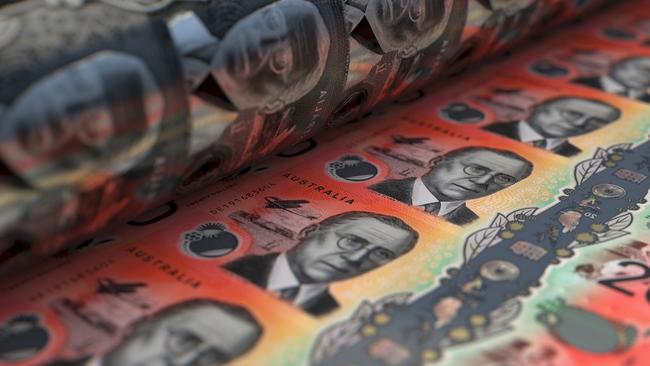Banks face funding increases as the RBA’s pandemic lifeline expires
Australian banks face the prospect of higher funding costs because $104bn of cheap term funding from the RBA, implemented during the height of the pandemic, is due to expire.

Australian banks face higher funding costs because $104bn of ultra-cheap term funding from the nation’s central bank is due to expire by mid year.
The $188bn of cheap loans from the RBA, which carried almost no interest for up to three years and were granted at rates as low as 0.10 per cent, was a reprieve for banks during the worst of the Covid-19 pandemic in 2020.
The facility, which closed on June 30, 2021, also levelled the playing field between small and large lenders and subsequently fuelled bumper profits for banks across the board.
With the outstanding $104bn of such loans expiring by June 30, margins – a key measure of bank profitability – as well as profits, will be squeezed, and particularly at the smaller regional lenders.
“Funding costs are expected to rise as banks replace Term Funding Facility (TFF) with conventional sources of funding,” says E&P Capital banking analyst Azib Khan. “I expect the pressure to be greater for regionals due to their inferior credit ratings.”
The Reserve Bank’s Term Funding Facility was provided at rates between 0.10 and 0.25 per cent to all banks.
By comparison, the nation’s largest lender, Commonwealth Bank, in August last year raised $1.5bn in three-year bonds, paying rates 0.75 percentage points above the bank bill swap rate, which currently sits at 4.35 per cent – equivalent to quarterly coupons of 5.10 per cent.
As things normalise, the jump in funding costs is higher for all other banks, particularly in wholesale debt markets, as CBA demands the cheapest pricing of all Australian lenders. Even then CBA in November said margins had been hurt in its first quarter of the 2024 financial year from a competitive deposit market.
It also said it had raised about $10bn in deposits in the three months to the end of September, and $17bn in long-term wholesale funding or about half of its funding requirement for the 2024 fiscal year.

The nation’s largest lender funds the majority of its operations with customer deposits, with about seven of every 10 dollars funded that way. The rest is sourced mainly with debt – through bond markets – and a minor part with equity.
An ACCC paper released last month shows CBA pays retail depositors base rates of between 0 per cent to over 2 per cent, while offering rates around 5 per cent on term deposits.
Earlier this week, Westpac paid 0.82 percentage points above the benchmark rate for $1.5bn in floating rate bonds maturing in three years. The deal is likely to have benefited from strong demand for bonds at the beginning of a year when interest rates are expected to fall, analysts said.
Smaller peers Bendigo and Adelaide Bank, Suncorp Bank and Bank of Queensland can expect to pay higher rates when seeking to raise debt funding. This is due to their lower credit ratings, which reflect a relatively weaker financial profile.
“The TFF had somewhat levelled the funding playing field between the majors and regionals as the cost to access TFF was the same for all,” Mr Khan said. “The regionals will now be going back to their natural funding disadvantage relative to the majors.”
CBA, Westpac, ANZ and NAB are rated AA-minus and Aa3 by S&P Global Ratings and Moody’s Investors Service, respectively. BOQ and Bendigo are rated BBB-plus and A3 by the same agencies. Suncorp’s banking subsidiary, Suncorp Metway, is rated A-positive by S&P and A1 by Moody’s.
BOQ last month raised $250m in debt maturing in a year paying a coupon of 0.87 percentage points over the bank bill swap rate. On Wednesday, Citi downgraded Bendigo and BOQ to sell. The broker also has sell calls on CBA and NAB, and rates Westpac and ANZ as neutral.
“There still remains about $100bn of TFF to be repaid back to the RBA by June 2024,” Citi analyst Brendan Sproules said. “This is looking like an achievable task, with the assistance of wholesale markets. However, this process is slowing credit growth, reducing the amount of liquidity to the private sector.”
The dynamic is also expected to keep competition for deposits at intense levels, as banks rush to repay their loans to the RBA.
Competition could also intensify if credit growth accelerates from its rate of 4.5 per cent (when including growth in the non-banking sector) or 5.3 per cent in the banking system.
“The withdrawal of liquidity will impact in a number of forms,” Mr Sproules said, including the ongoing compression of returns in the retail banking units of the banks in 2024. Although that is expected to bottom out.
In the last 18 months, banks have used the cheap loans to fund generous cashback offers on mortgages that elbowed out smaller non-bank competitors, for which the TFF was not available and must fund their operations through wholesale debt raisings or through banks.
“The excess liquidity that was pumped into the financial system during Covid ultimately subsidised competition in mortgages,” Mr Sproules said.







To join the conversation, please log in. Don't have an account? Register
Join the conversation, you are commenting as Logout